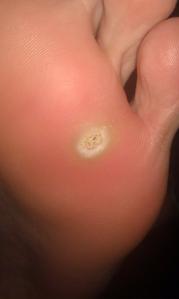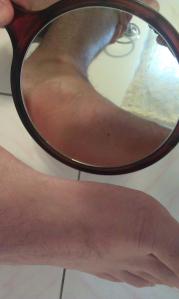Plantar warts are caused by a few of the 120 types of human papillomavirus, or HPV. The virus affects the superficial areas of the skin, especially on the pressure points of the foot such as the heel and the ball of the foot. Since it is a virus, it is contagious. It typically enters through small cuts or irritated areas in the skin, or areas that are constantly exposed to water.
What does a plantar wart look like?

A lifeguard/swim instructor developed a plantar wart on the ball of the foot as a result of long hours working in constantly wet, bare feet.
Plantar warts are small, grainy, callus-like lesions on the bottom of the foot. There may be a single wart measuring about 2 – 3 cm; a large “mother wart” surrounded by several smaller warts; a cluster of warts grouped together, otherwise known as a mosaic wart. The centre of the wart(s) have tiny red or black dots caused by trapped capillaries. On weight-bearing surfaces, the warts may be flattened.
How do you get plantar warts?
- the virus enters through tiny cracks in dry skin
- through cuts, scrapes and other skin irritations
- through wet, softened skin from prolonged exposure to water
Who usually gets plantar warts?
- children and teenagers since their immune system is not fully developed and since they are more likely to go barefoot
- people with weakened immune systems
Home remedies for plantar warts
- apply a doughnut-shaped pad (available at drugstores) around the plantar wart to reduce pressure on the area when weight-bearing
- try an over-the-counter medicated wart remover. Since these preparations may chemically burn the skin, protect the area around the wart with a light coating of petroleum jelly. This remedy is not recommended for young children or diabetics.
- gently rub the callused area with a pumice stone after soaking in a vinegar-water solution for 10-15 minutes
- apply duct tape over the wart. Change as needed if it becomes wet. Re-assess the area after 3 – 4 days and leave the tape off overnight if the skin underneath appears wet. You may apply a drop of tea tree oil before applying the tape. It may take 6 – 7 weeks to eradicate the wart using this treatment.
When to see your doctor
- if after 2 weeks of applying home remedies, there is no noticeable change
- if new growths keep appearing
- if you are unsure the growth is a wart
- if you have a previous history of skin cancer or have a close family member with a history of skin cancer
- if you are diabetic
How to prevent plantar warts
- avoid walking barefoot in public shower stalls, change rooms, swimming pools, saunas
- change your socks daily
- check the bottom of your feet daily. If needed, use a mirror.

If needed, use a mirror to check the bottom of the feet.
- keep feet clean and dry
- do not touch warts on other people
- if you touch a wart on yourself or on someone else, wash your hands thoroughly for at least 15 seconds using warm, soapy water
- don’t scratch warts since this encourages their spread
- don’t share shoes and socks
- cover warts with waterproof tape while in swimming pools or shower stalls
Diabetes and plantar warts
If you are diabetic, always have your doctor treat plantar warts. Complications such as poor nerve functioning(neuropathy) and decreased blood circulation (micro/macroangiopathy) make home treatments dangerous for people with diabetes.
Since diabetics have concerns with decreased nerve functioning in their feet (neuropathy), it may not be possible to feel discomfort from a plantar wart. Daily checking the entire foot to detect new growths or lesions is important.
Over – the – counter wart removers should not be used by diabetics since there is the strong possibility that harsh chemicals in the preparation may irritate healthy skin surrounding the wart. These irritations may aggravate the area and cause skin infections. Because of poor circulation, any skin infection in the feet of diabetics must be treated aggressively.

